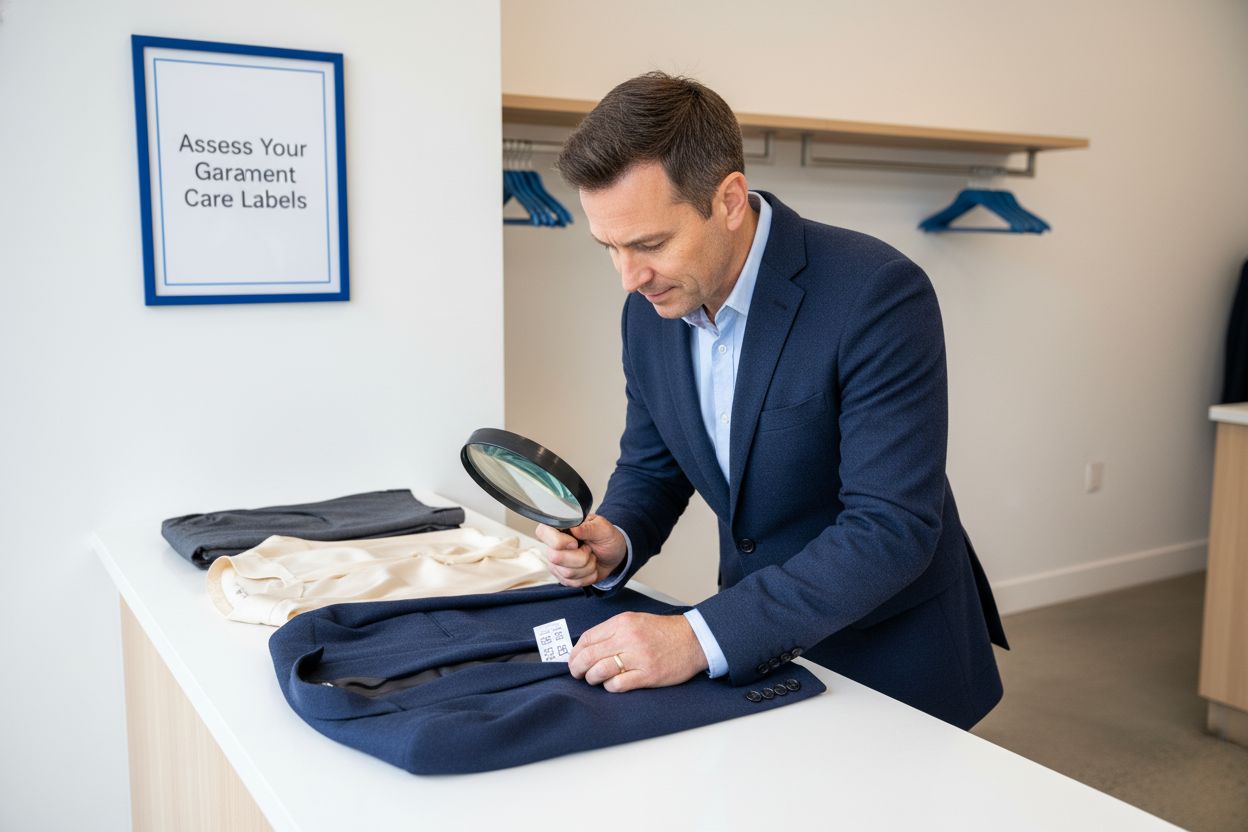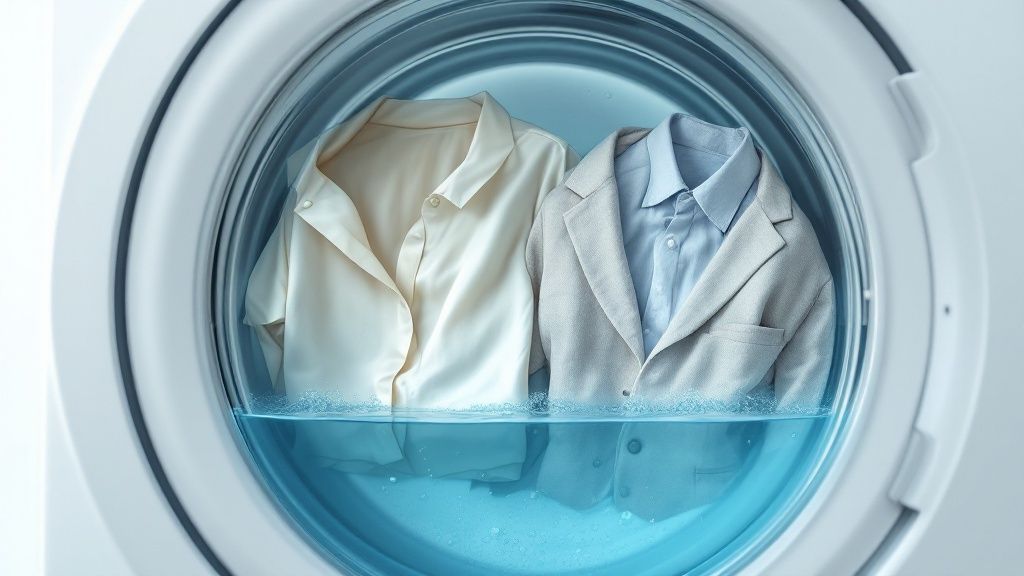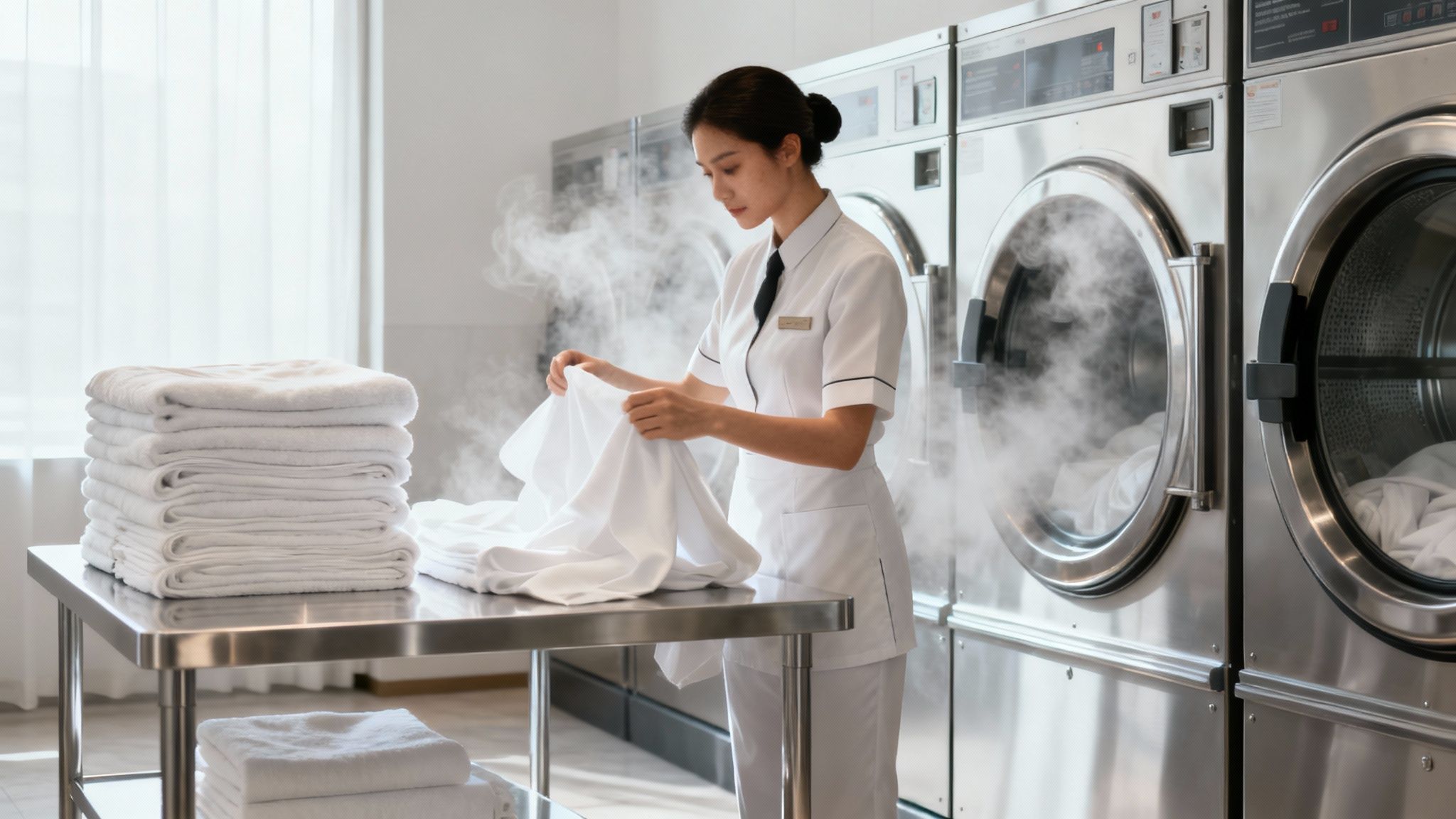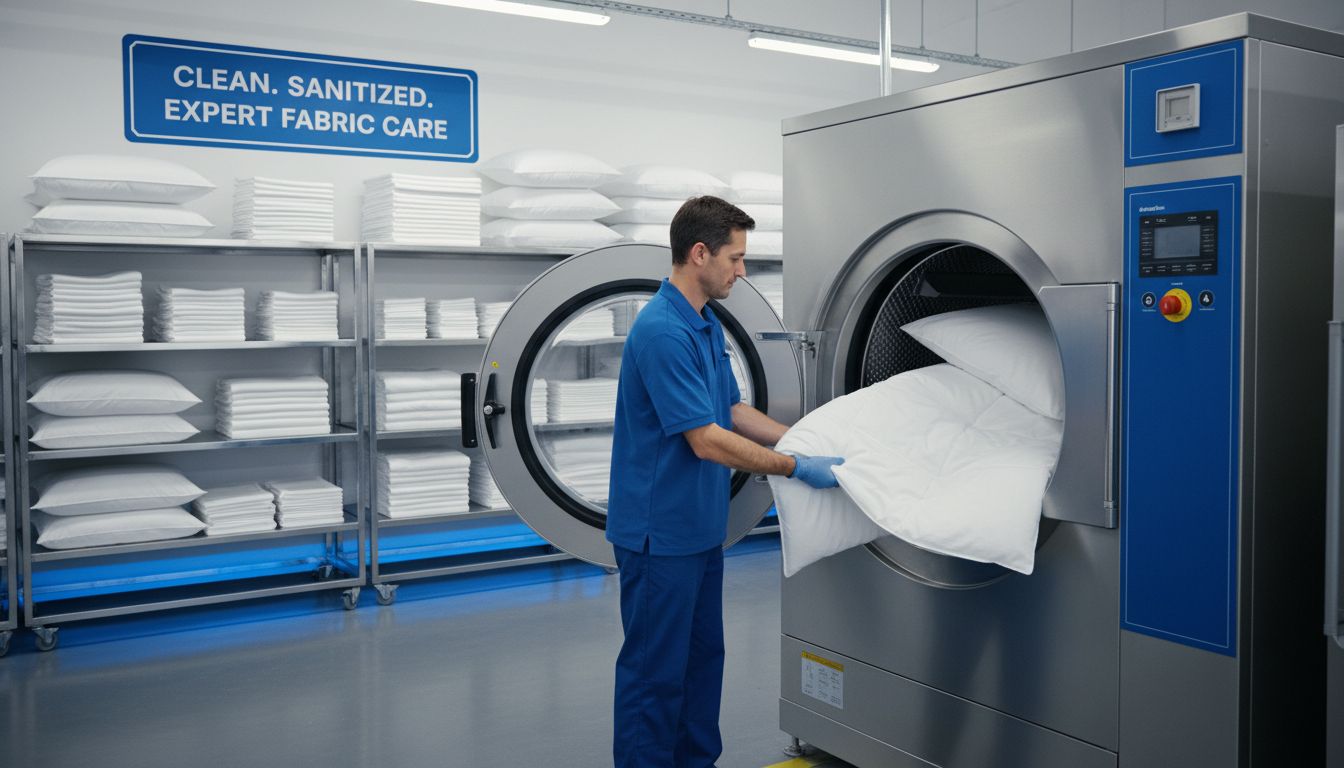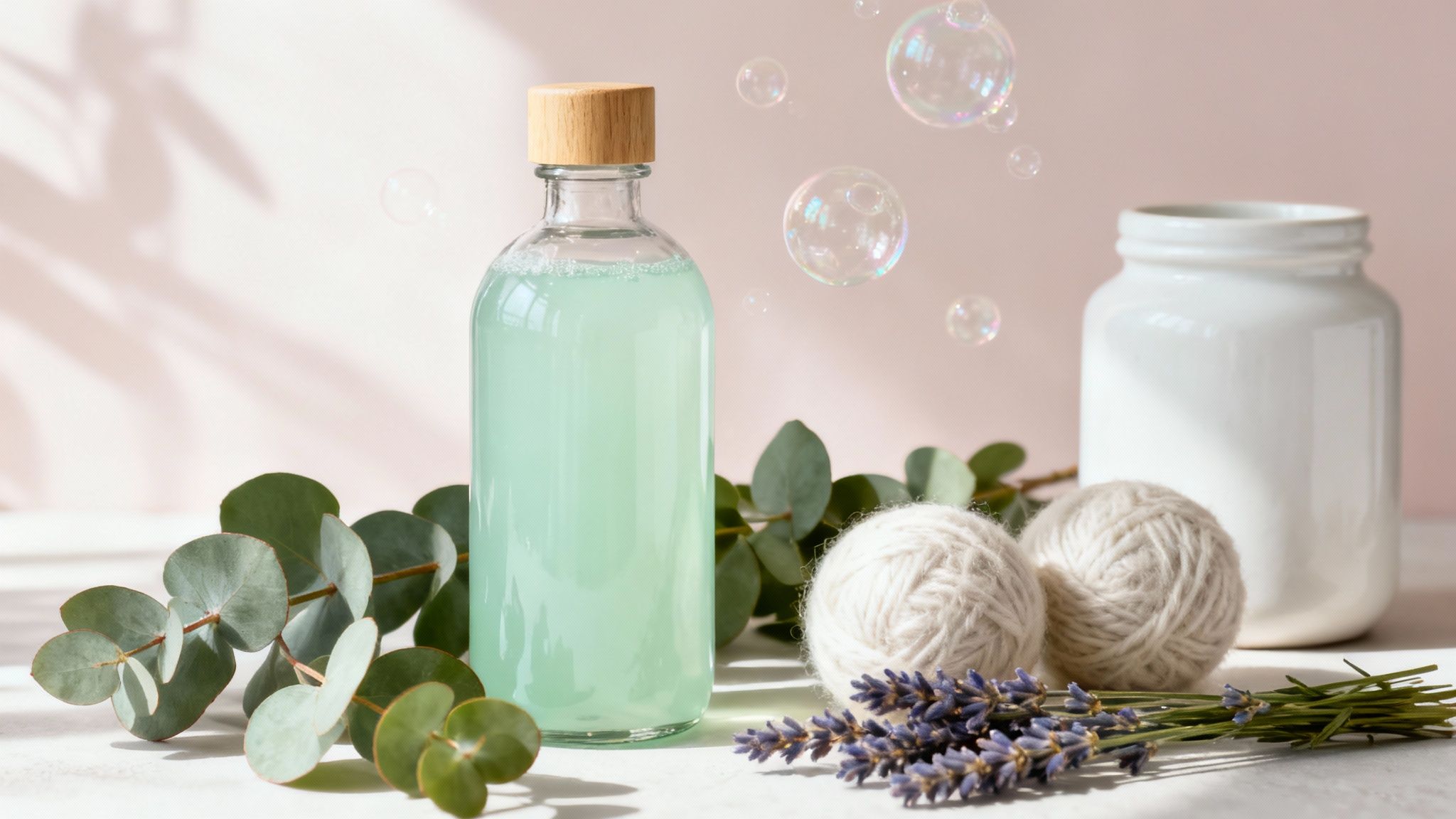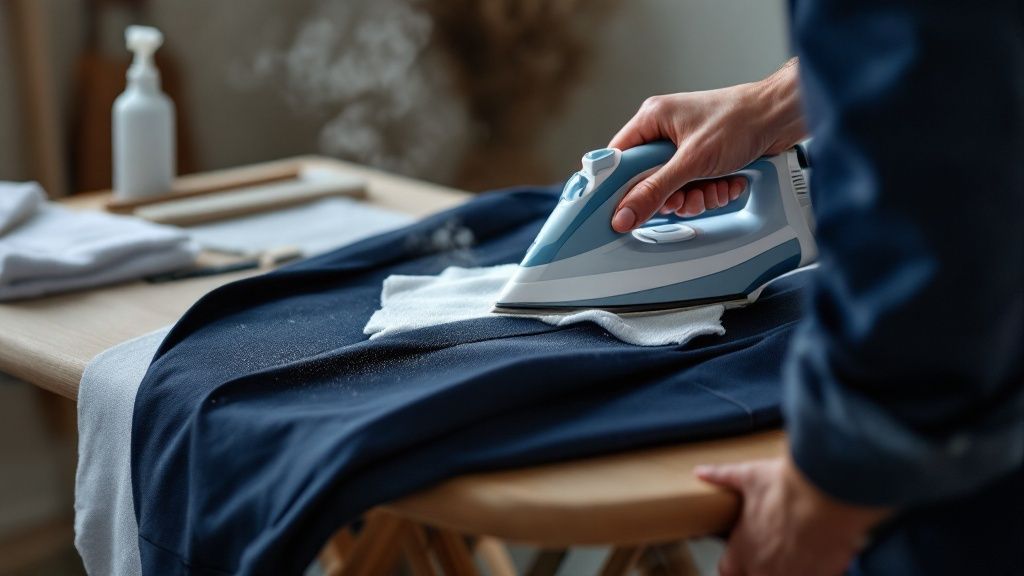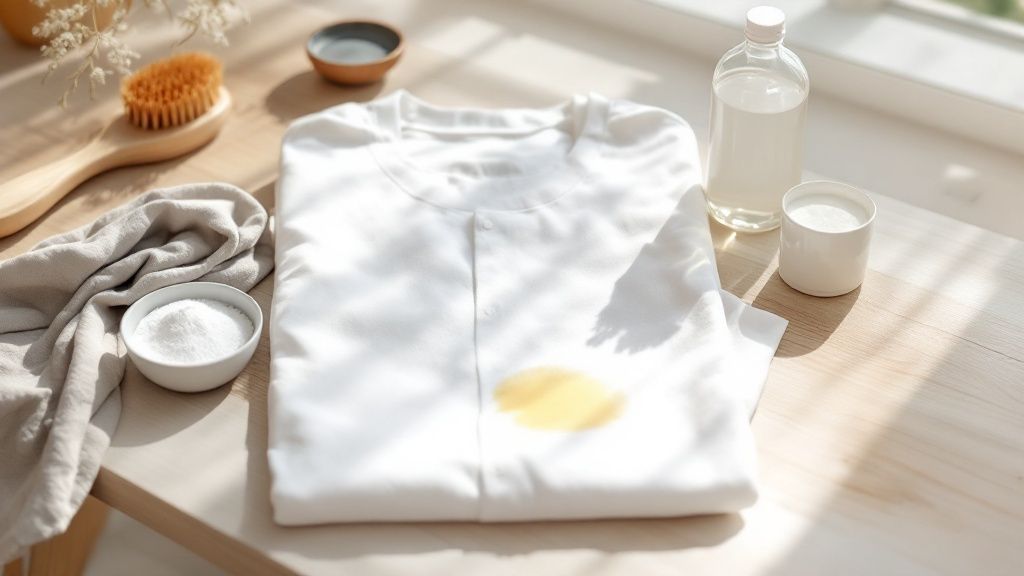How to Get Mildew Smell Out of Clothes for Good
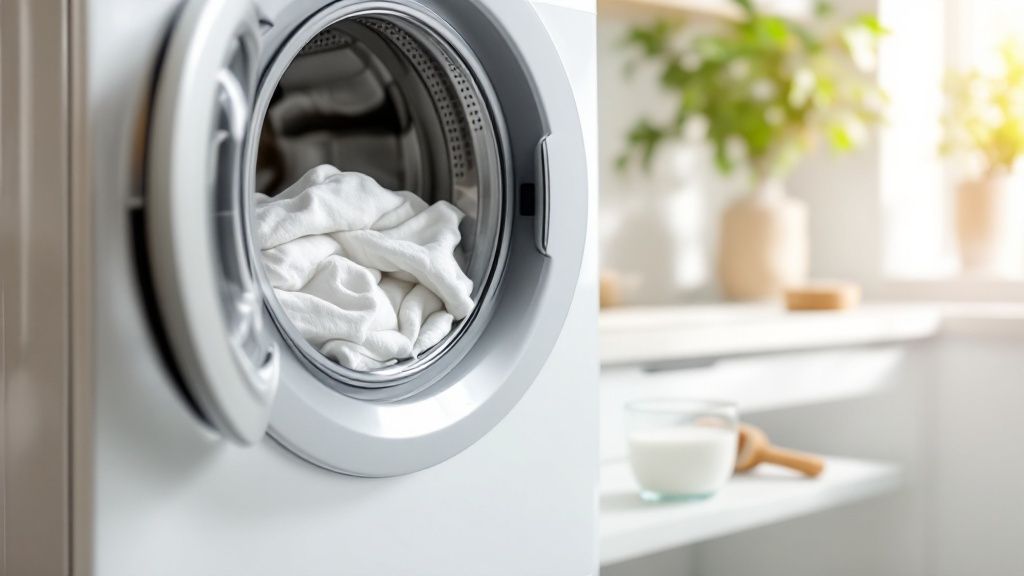
To get that mildew smell out of your clothes, you'll need an odor-killing agent like white vinegar or baking soda added to your wash cycle. If the smell is really stubborn, a pre-soak in a vinegar solution is your best bet. Follow that up with a wash on the hottest setting the fabric can handle, and you’ll effectively kill the mold and bacteria causing the stink.
Why Your Clean Clothes Still Smell Like Mildew
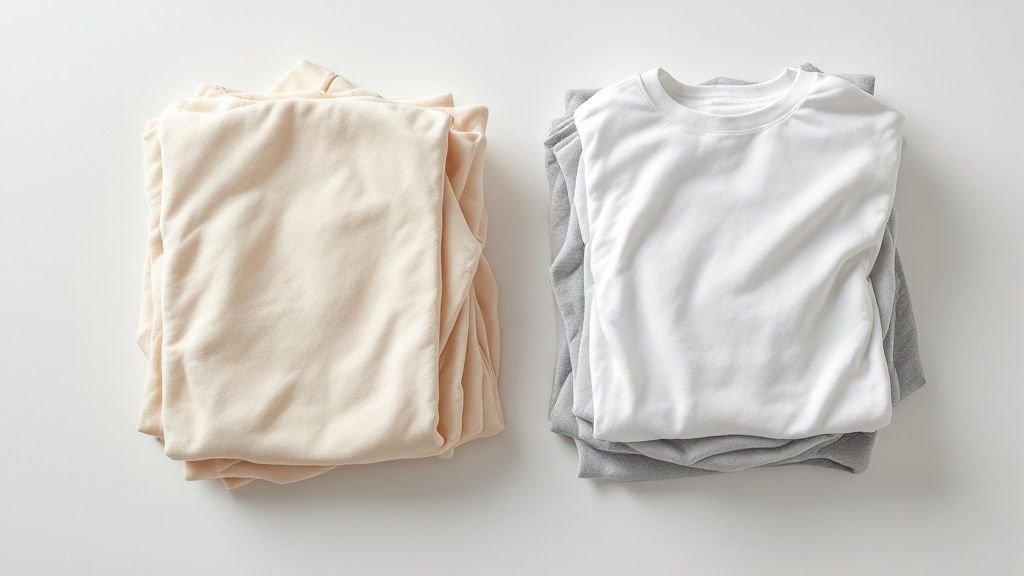
It's one of the most frustrating laundry moments: you pull a "clean" shirt from the dryer, but it’s still holding onto that damp, musty odor. You know you used enough detergent, so what gives? The problem isn’t about a lack of soap—it's about the microscopic culprits thriving deep within the fabric fibers.
That signature mildew odor is caused by mold and bacteria that have set up camp in your clothes. This usually happens for a few all-too-common reasons:
- Leaving wet clothes in the washer. We’ve all done it, but even a few hours is more than enough time for smelly microbes to multiply in the damp, dark machine.
- Not drying completely. Putting away clothes that are even a little bit damp is an open invitation for mildew to grow inside your drawers or closet.
- A dirty washing machine. Over time, soap scum, lint, and hard water deposits can build up a grimy biofilm inside your washer's drum and gaskets. This gunk becomes a breeding ground for mildew that then transfers to every single load you wash.
Sometimes, the source of a persistent mildew smell isn't even in the clothes or the machine itself, but in the plumbing. If water isn't draining correctly, it can leave moisture behind that fuels the problem. If you think this might be happening, you may need to fix a washing machine drain backup.
The science behind the smell is pretty clear: certain bacteria and fungi are tough enough to survive a normal wash cycle, especially in cold water. It's estimated that up to 20-30% of clothes can still have that musty smell after washing, particularly when washed at temperatures below 140°F (60°C).
Ultimately, the main reason for mildew smells is the growth of mold and bacteria in fabric fibers, which is often kicked off by incomplete drying or using low-temperature wash cycles. Studies have shown that certain bacteria are responsible for the compounds that create these smells, and they can easily survive standard laundering—especially in synthetic fabrics like polyester.
The good news? This is a totally solvable problem. With the right approach, you can knock out the existing odor and keep it from coming back for good.
Home Remedies to Kick That Mildew Smell to the Curb

Before you even think about buying a special, pricey detergent, take a peek in your pantry. Chances are, you already have the two most powerful weapons against mildew smell right there: distilled white vinegar and baking soda. These kitchen workhorses are brilliant at neutralizing odors right at the source.
A pre-soak is your first line of attack. Just mix one part white vinegar with four parts cool water in a tub, a basin, or even a clean sink. Dunk your musty clothes in there, making sure they’re completely submerged, and just let them hang out for at least an hour. The acetic acid in the vinegar gets to work breaking down all the nasty, odor-causing bacteria clinging to the fabric.
This trick is anything but new. Vinegar and baking soda have been the go-to fix for over a century. If you look at old household manuals from the early 1900s, you'll see similar advice for dealing with musty smells. You can read more about how these traditional remedies work and see just how long they've been effective.
Time for a Baking Soda Boost in the Wash
Once your clothes have had a good soak, it's time for the washing machine. Don't bother wringing them out too much—just transfer them straight into the drum. Now, it's baking soda's turn.
Toss about half a cup of baking soda right into the drum on top of your clothes. Baking soda is a natural deodorizer and will absorb any stubborn smells the vinegar might have missed. As a bonus, it also helps soften the water, which gives your regular detergent a nice performance boost.
Now, just run a wash cycle with your normal detergent. Be sure to use the hottest water setting your clothes can handle (always check the care label!). That heat is absolutely critical for killing off any mold or mildew spores that are still hanging on.
Pro Tip: Never pour vinegar directly into your washer's bleach dispenser. Over time, it can chew through the rubber seals and cause damage. It's much safer to use it for a pre-soak or add it to the fabric softener dispenser during the rinse cycle.
Let the Sun Do the Heavy Lifting
When the wash cycle is done, don't skip this last, crucial step: drying everything properly. If you can, hang your clothes outside in direct sunlight. This is nature's disinfectant. The sun's UV rays are incredibly effective at killing off any last traces of bacteria.
It's the perfect finishing touch that not only zaps any lingering musty scent but also gives you that amazing, genuinely fresh laundry smell. For more tips on keeping your laundry smelling great, check out our guide on how to make your clothes smell fresh.
If line-drying isn't an option, no worries. Just use your machine dryer on a high heat setting. The key is to make sure every single item is completely bone-dry before you even think about folding it and putting it away.
Choosing the Right Laundry Products and Machine Settings
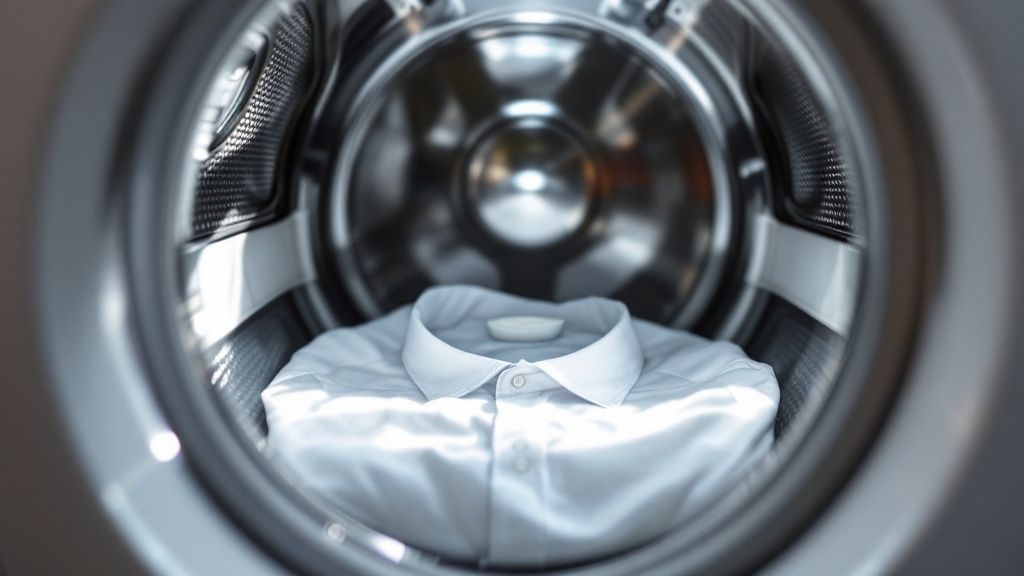
While home remedies like vinegar and baking soda are fantastic for mild cases, sometimes you're dealing with a mildew problem that just won't quit. When that funky smell is really dug in, it's time to bring out the big guns from the laundry aisle.
The trick is to look past your everyday detergent. You need products specifically engineered to destroy the microbes that are causing that musty odor in the first place. Think of it this way: regular soap just lifts dirt, but you need something that gets down to the microscopic level to kill the bacteria and fungi. That's where laundry sanitizers and enzymatic cleaners come in.
Powerful Products for Odor Elimination
When you're trying to figure out how to get that mildew smell out of clothes for good, you’ll find a couple of go-to product types that really work:
- Enzymatic Detergents: These are a lifesaver for workout clothes and other synthetics. They use special enzymes to break down the gross stuff mildew loves to feed on—like sweat and body oils.
- Laundry Sanitizers: Look for products with active ingredients like quaternary ammonium compounds. These are designed to kill bacteria and fungi without having to resort to harsh bleach. You usually just add them to the rinse cycle to fully disinfect your fabrics.
These aren't just marketing gimmicks; they have a proven track record. For instance, specialized detergents like Persil Activewear Clean have shown effectiveness rates over 85% in knocking out mildew-related odors. On the sanitizer side, brands like Lysol and Clorox often claim to kill up to 99.9% of odor-causing bacteria and fungi, which is a huge step toward making sure that smell doesn't come back. You can find more details on these in this laundry odor removal guide.
Choosing the right additive can make all the difference. Here’s a quick comparison to help you decide what your laundry room needs.
Odor-Fighting Laundry Product Comparison
Ultimately, the best product depends on your specific problem. For a true mildew infestation, a sanitizer is your best bet, while an enzymatic detergent is great for routine prevention on activewear.
Fine-Tuning Your Machine Settings
Even the best product won't work its magic if your machine settings aren't right. This is where a lot of people go wrong. The single most effective change you can make? Turn up the heat.
Key Takeaway: Always use the hottest water setting that your fabric's care label allows. Hot water is incredibly effective at killing mold spores and bacteria that can easily survive a cold wash.
For tough items like cotton towels, sheets, and socks, don't be afraid to use a hot or "sanitary" cycle if your machine has one. For more delicate items that can't handle the heat, a warm wash is still a huge improvement over a cold one.
When you combine a powerful, targeted product with the right machine settings, you've got a surefire strategy for winning the war against mildew for good.
Dealing with That Stubborn Mildew Smell in Towels and Gym Clothes
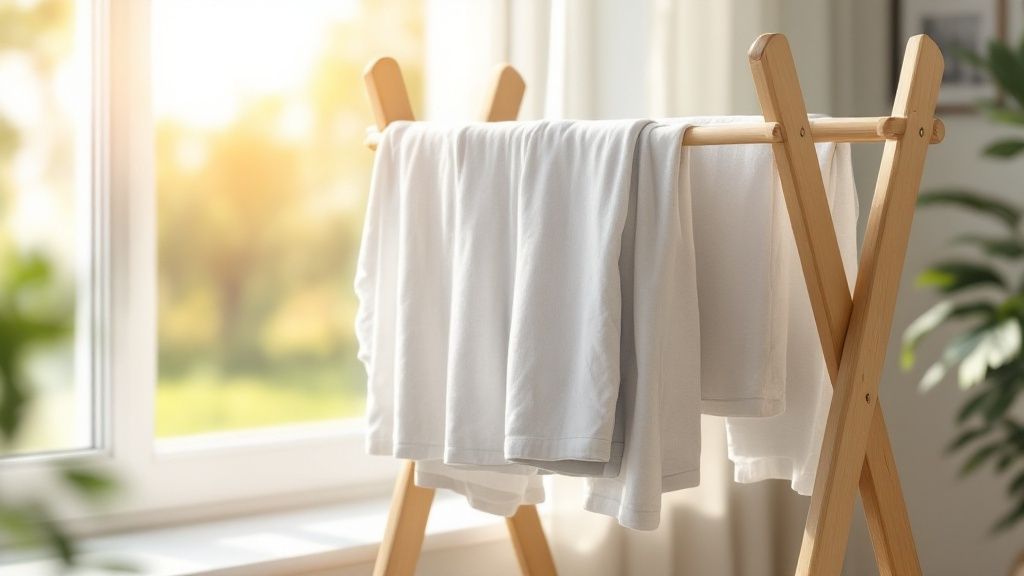
Let’s be honest, some fabrics are just magnets for that musty, mildewy funk. The two biggest offenders in almost every household? Those thick, fluffy cotton towels and our modern, synthetic gym clothes.
It's a perfect storm, really. These materials are fantastic at trapping moisture and bacteria, which is exactly what mildew needs to thrive.
Think about it: towels, with their super-absorbent cotton loops, can feel dry to the touch but still hold onto moisture for ages, especially in a steamy bathroom. That lingering dampness is basically an open-house invitation for mildew.
Then you have your high-performance workout gear. It’s designed to pull sweat away from your skin, but those amazing moisture-wicking fibers are also great at clinging to body oils and bacteria. This creates a stubborn, sour smell that a normal wash cycle often can't touch.
A Deep-Clean for Your Toughest Laundry
For towels that have become stiff or have a smell that just won't budge, you might need to bring out the big guns. There's a deep-cleaning technique called laundry stripping that works wonders. It uses a specific combination of hot water and cleaning agents to literally pull out all the built-up residue that regular washing leaves behind. It’s a bit of a process, but it's incredibly satisfying and can revive towels you thought were a lost cause.
With activewear, the best defense is a good offense. The golden rule is to never let sweaty gym clothes fester in a hamper or a zipped-up gym bag. As soon as you get home, hang them up somewhere to air out completely before they hit the laundry basket. This one simple step deprives mildew of the damp environment it needs to grow.
At the end of the day, conquering mildew in these tricky fabrics isn't about masking the smell. It's about getting to the root of the problem—the trapped moisture and bacteria. A proactive approach is what will keep them smelling fresh long-term.
It's also worth looking into detergents made specifically for performance fabrics. We dive deeper into this in our guide on how to keep your athletic wear fresh and functional. These specialized formulas are much better at breaking down sweat and body oils without harming those delicate synthetic fibers.
To really target the mildew smell in these items, try these specific tactics:
- For Towels: Give them their own dedicated load and use the hottest water setting the care label allows. For an extra kick, add a laundry sanitizer to the wash to really disinfect them.
- For Gym Clothes: Wash them as soon as you can after a workout. Always turn your gear inside out before tossing it in the machine—this gives the detergent direct access to all the grime and bacteria.
You’ve finally gotten that musty, mildew smell out of your clothes—fantastic! But the real victory is making sure it never comes back. The secret isn't some complicated process; it's all about building a few simple, powerful habits into your laundry day. This shifts you from constantly fighting the funk to preventing it from ever starting.
The biggest game-changer is speed. Moisture is mildew’s best friend, so you need to break them up fast. Make it a hard and fast rule: transfer clothes from the washer to the dryer immediately. I can't tell you how many times I've seen a load of laundry ruined because it sat for just a few hours. That’s all it takes for mildew to get a foothold.
Next up, make sure everything is 100% bone-dry before it gets folded and put away. We've all been there—the thick waistband on a pair of jeans or the heavy seams on a hoodie feel dry to the touch, but they’re secretly holding onto dampness. Give those items an extra few minutes in the dryer or some time on a drying rack. It makes a world of difference. And for anything that can't be machine-dried, knowing how to air dry clothes indoors the right way is your best defense against that damp smell.
Is Your Washing Machine the Real Culprit?
Sometimes, the source of that mildewy smell isn't your clothes at all—it's the machine. Your washer's warm, damp environment is the perfect breeding ground for biofilm, which is just a fancy name for the slimy gunk made of soap scum, lint, and bacteria. This stuff builds up and transfers its musty odor to every single load you wash.
Give your machine a quick clean-up once a month to keep it fresh. It’s easier than it sounds.
- Tackle the Gasket: If you have a front-loader, that rubber door seal is a prime spot for gunk. Wipe it down with a cloth soaked in vinegar or a proper machine cleaner. Don't forget to gently pull back the folds to clean out the grime hiding inside.
- Wipe Down the Drum: Give the inside of the drum a quick wipe to get rid of any residue.
- Run a Cleaning Cycle: You can use one of those commercial washing machine cleaner tablets or just run an empty cycle on the hottest setting with a cup of bleach or two cups of white vinegar.
The best defense against mildew is being proactive. It's a lesson that applies all over the home. You can even borrow some strategies for preventing mold and mildew growth from other areas to see how the same principles work everywhere.
Finally, one of the easiest habits to adopt is simply leaving the washer door open after every wash. This lets the interior air out completely, starving any potential mildew of the moisture it needs to thrive. A simple, free step that keeps both your machine and your clothes smelling fresh.
Your Questions About Mildew in Clothes Answered
Even when you follow all the steps, a few questions about that musty laundry smell can pop up. Let's tackle some of the most common things people wonder about when trying to get rid of mildew for good.
Can the Mildew Smell in Clothes Make You Sick?
That musty odor itself is just unpleasant, but it’s a big red flag for mold and bacteria. For most of us, this might just mean some minor irritation, if anything at all.
However, if you or someone in your family has allergies, asthma, or a compromised immune system, it's a different story. Constant exposure to mold spores on clothes can potentially trigger respiratory issues, skin irritation, or allergic reactions. The most important thing for your health and comfort is to get rid of the source of the smell.
The bottom line is that while the smell won't harm you, the mold causing it can be problematic for sensitive individuals. Prioritizing its removal is always the best course of action.
Is It Safe to Mix Vinegar with My Laundry Detergent?
Yes, it's totally safe—and really effective—to use both white vinegar and detergent in the same wash load. But there's a trick to it: you can't add them at the same time.
If you pour vinegar and detergent into the dispenser together, you’ll run into a little chemistry problem. The acid in the vinegar can cancel out the alkaline cleaning agents in your detergent, making both of them less effective.
Here’s how to do it right:
- Detergent: Add this to the main wash cycle, just like you normally would.
- Vinegar: Pour about a cup of white vinegar into the fabric softener dispenser instead. This tells the machine to release it during the rinse cycle, where it can soften fabrics and knock out any last odors without getting in the way of the soap.
Why Do My Clothes Smell Fine Out of the Dryer but Musty Later?
Ah, the classic mystery. This is an incredibly common—and frustrating—problem, and it almost always points to one culprit: lingering moisture. Even when clothes feel perfectly dry to the touch, a tiny bit of dampness can get trapped in thick seams, cuffs, or waistbands.
Once you put those slightly damp clothes away in a dark closet or a crammed drawer, you've created the perfect warm, humid playground for any dormant mildew spores. They reactivate and start producing that musty smell all over again.
Always err on the side of being overly cautious. For thicker items like jeans or hoodies, either run them through an extra drying cycle or hang them in a well-ventilated spot for a few hours. You want to be absolutely sure they are 100% bone-dry before they go anywhere near a drawer.
Tired of the endless laundry battle? Let Columbia Pike Laundry give you back your time and peace of mind. Our pickup and delivery service handles everything with professional care, so you can enjoy fresh, perfectly clean clothes without the hassle. Schedule your first pickup today and rediscover your weekend.
Popular Blog Articles

Meet the Author
Daniel Logan didn’t start CPL because he loved laundry. He started it because his family was drowning in time debt, and laundry was one of the biggest weights.
Mornings were chaos with two kids under 5. Evenings felt like catch-up. And weekends? Gone to sorting socks and folding piles.
He knew his story wasn’t unique. So he built a business that gave families like his just a little bit of breathing room one load at a time.
With no laundry experience but deep tech skills, Daniel rolled up his sleeves, doing every job himself while building systems that turned it into a modern laundry service that saves customers time, simplifies their lives, and delivers reliability they can count on.
That’s where CPL began. Not from a playbook, but from pain. From one dad trying to buy back time: for himself, and for every household like his.


